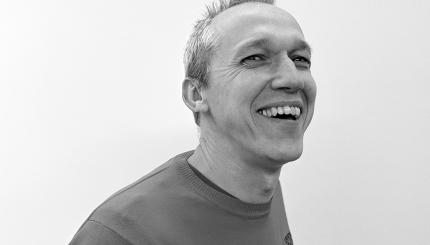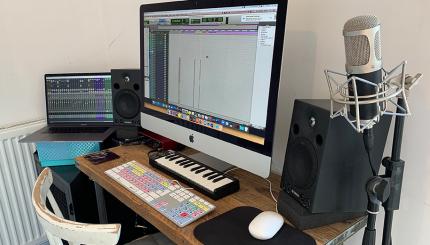
The Gramercy Park Studios sound designer discusses his daily listening diet, the most satisfying part of his job and how the industry is forever evolving
Thinking in Sound is a new feature from LBB that delves into the minds of the industry’s fantastic music and sound specialists, showing us just how creative this part of the industry is. We dig into inspirations, passions, and approaches to work, whilst also getting a taste of how the industry is changing.
To kick off our first ever Thinking in Sound, we speak to Gramercy Park Studios sound designer Sam Cross about his relationship with music, from audio heroes to the power of ambient sound.
When you’re working on a new brief or project, what’s your typical starting point? How do you break it down and how do you like to generate your ideas or response?
Sam > For me, I always like to start with cleaning up any existing sound that will be used in the film or commercial. This serves as a great idea generator, as it helps solidify the storyline in my mind, and I begin to tackle how best to maximise any emotion or message that should be evoked. It also sharpens the focus on any weak points in the soundtrack, putting those mental markers down gets the creative juices flowing!
Music and sound are in some ways the most collaborative and interactive forms of creativity - what are your thoughts on this? Do you prefer to work solo or with a gang - and what are some of your most memorable professional collaborations?
Sam > I really like to work as part of a team, getting feedback from people who think differently to yourself can open your eyes to some alternative approaches to the problems you encounter, or just freshen up your ideas and send you down a different path. One job that sticks in my mind was a Chiltern Railways radio commercial. There was an offer in conjunction with a rail ticket to get a discount on a ride down the Arcelor Mittel Orbit in the Stratford Olympic Park. For those who don’t know, this is a huge enclosed slide, the ceiling of which is interspersed with clear viewing windows and travels from the top of the tall structure, to the bottom. You get incredible views over London whilst going down. We could have created the sound artificially in the studio, however, the agency had the idea of recording the voiceover artist reading the script whilst going down the slide! We did about seven runs with various mics strapped to the voiceover artist, then took the recordings back to the studio for the mix. It yielded really successful results, and was a great example of a collaboration taking a project in a different direction.
What’s the most satisfying part of your job and why?
Sam > The sound mix is usually the final piece of the jigsaw in a production, and so the session in the studio can be the very first time everyone sees a production come together, from inception to finished product. It can be really rewarding to be a part of that moment, as the project is brought to life for the first time in front of everyone’s eyes… and ears of course.
As the advertising industry changes, how do you think the role of music and sound is changing with it?
Sam > I think there is far more awareness now of what can be achieved with top music and sound production on a project these days. We frequently find ourselves involved in the pre production phases of projects now, offering insight into how we can achieve ever more interesting and creative goals. Technological advances constantly drive new ideas, and new software offers a wealth of cutting edge tools for sound generation and manipulation. The mediums for consuming content seem forever evolving, presenting vast opportunities for creative sound implementation into the future.
Who are your musical or audio heroes and why?
Sam > I have many many heroes that inspire me in the audio world, but I’m totally in awe of the top music mix engineers. People like Andrew Scheps, Adam Getgood, Michael Brauer, Tony Maserati, Manny Marroquin and many more. The skill involved in taking 100+ track Pro Tools sessions and finding a space for everything in a mix is incredible. All these guys have such an ear for extracting every last drop of emotion from a track and listening to their productions as an audio engineer/sound designer is an absolute joy! The value they add is so under-appreciated in my opinion.
And when it comes to your particular field, whether sound design or composing, are there any particular ideas or pioneers that you go back to frequently or who really influence your thinking about the work you do?
Sam > The concept I come back to the most is to identify the key sound cues for each scene, and ensure that they are the most prominent and grab the listeners’ attention ahead of any other sounds. The brain cannot digest multiple sound cues simultaneously, the scene may only be short, so make sure you are hitting the key sounds, and mix anything else distracting down. It’s easy to forget what it’s like to hear a scene for the first time when you have been working on it for hours. It is also hard to resist the temptation to feature a sound you’re really proud of, even if it isn’t key to the story. Make it easy for the listener, and guide them through the narrative!
When you’re working on something that isn’t directly sound design or music (lets say going through client briefs or answering emails) - are you the sort of person who needs music and noise in the background or is that completely distracting to you? What are your thoughts on ‘background’ sound and music as you work?
Sam > Personally I get completely distracted by any sort of audio when I’m working, be that music or a lawnmower next door! I can’t help but tune into whatever sound might be distracting me, completely forgetting about the current task in hand. Silence is the only option for focused work, and preferably in the morning too with a large cup of good coffee!
The quality of the listening experience and the context that audiences listen to music/sound in has changed over the years. There’s the switch from analogue to digital and now we seem to be divided between bad-ass surround-sound immersive experiences and on-the-go, low quality sound (often the audio is competing with a million other distractions) - how does that factor into how you approach your work?
Sam > Your job as a sound designer/audio mixer is to get the mix to translate as successfully as possible, on the most common listening mediums for that content. The effectiveness of that starts from the inception of the sounds themselves. If you know the piece of content you are designing sound for is going to be played mostly on a mobile phone, it’s not worth basing your entire mix around a sub-bass drone, too deep for the like of a phone speaker to replicate. The final deliverable has a massive bearing on the path a particular project follows.
On a typical day, what does your ‘listening diet’ look like?
Sam > Pre-lockdown and not working from home, my listening diet would very much be a podcast on the tube, something Sam Harris or football related, a day of work in the studio, then some music for the way home. Once home, it would be rare for me to listen to anything in the evenings during the week, the ears need time to recuperate!
Do you have a collection of music/sounds and what shape does it take (are you a vinyl nerd, do you have hard drives full of random bird sounds, are you a hyper-organised spotify-er…)?
Sam > I have an iTunes music subscription where I do most of my listening and discovering on the move, during the day. However, I find myself digesting music in a different way using iTunes, skipping between single tracks on playlists etc. Sometimes nothing beats listening to a full album the old fashioned way, start to finish! All the classic albums that I love in their entirety, I collect on vinyl, proudly displayed in the living room!
Outside of the music and sound world, what sort of art or topics really excite you and do you ever relate that back to music?
Sam > I have recently started to get into photography at an amateur level. I feel there’s lots of crossover between photography and sound design, such as crystallising a few key elements to create, enhance or tell a story. A picture can tell a thousand words and all that…
Let’s talk travel! It’s often cited as one of the most creatively inspiring things you can do. What are the most exciting or inspiring experiences you’ve had when it comes to sound and music on your travels?
Sam > Since becoming a sound designer I am now very acutely aware of all ambient sound whenever I travel. I am sure to spend a couple of minutes just listening to any new environment storing a mental picture for when I’m back in the studio. It’s fascinating to hear how cities and countryside contrast throughout the world.
As we age, our ears change physically and our tastes evolve too, and life changes mean we don’t get to engage in our passions in the same intensity as in our youth - how has your relationship with sound and music changed over the years?
Sam > Yes those evenings of being in my bedroom playing guitar for hours on end are well and truly behind me! You definitely get fewer opportunities to engage with your passions as you get older, but I find myself compensating by using my time more intensely. By this I mean that if I know I only have a brief window to listen to some music or play my guitar, then I’ll try and do something productive with that time. Listen to something new, rather than the old favourites, learn a new riff or concept rather than blaze through the same songs I’ve been playing for years. I also find that it gets harder to be impressed the older you get. You’ve heard the same tricks many times both in sound design and music, so it’s harder to find something fresh, and harder to come up with new sounds and ideas yourself.
As originally featured in LBB
https://www.lbbonline.com/news/thinking-in-sound-sam-cross



